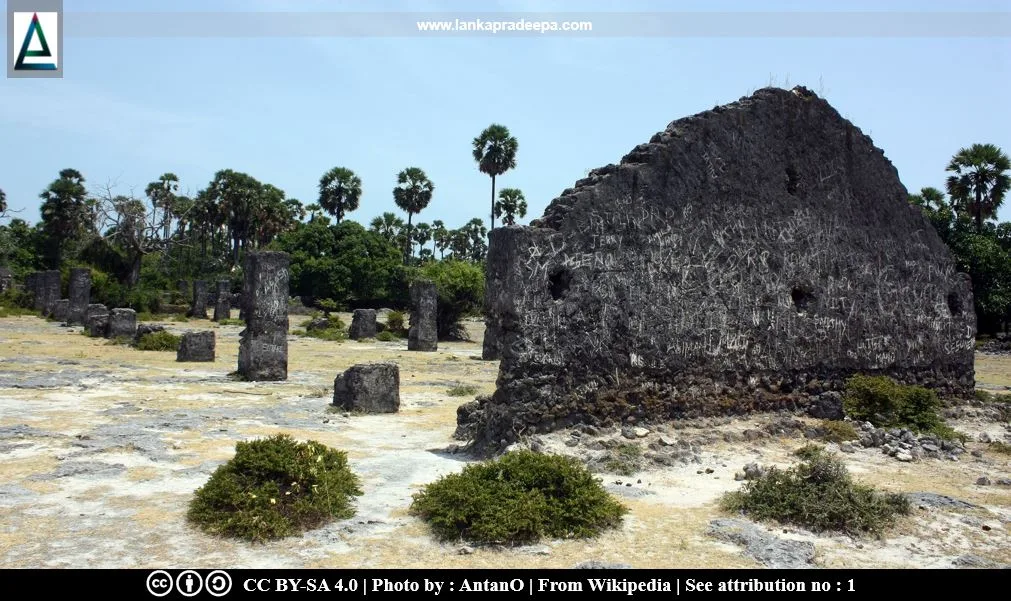
The remains of an Old Stable (Sinhala: ඩෙල්ෆ්ට් අශ්ව ස්ථාලය; Tamil: டெல்ஃப்ட் குதிரை லாயங்கள்) is found located in Sarappiddy village on the island of Delft (Tamil: Neduntheevu), in Jaffna District, Sri Lanka.
History
The wild horses found on the present Delft island are believed to be the offspring of the horses brought to the island from foreign countries by the Portuguese who had control of several coastal areas in Sri Lanka including the Jaffna Peninsula from 1597 to 1658 (Wijebandara, 2014). After the Portuguese, the Dutch occupied those regions from 1658 to 1796 and during this period the Delft island was an important administrative centre of them. Rev. Philippus Baldaeus
(1632-1671 A.D.), a Dutch minister who was in Jaffna during the Dutch period has mentioned in his travel records that the people on the island captured horses by chasing them towards swamps (Wijebandara, 2014).
In 1796, the British expelled the Dutch and eventually managed to bring Sri Lanka under the British flag by 1815. John Wilson (1780–1856 A.D.), the Governor of British Ceylon (present Sri Lanka) from 1811 to 1812, appointed Edward Nolan, a Lieutenant of the 4th Ceylon Regiment as the administrator of the Delft island (Wijebandara, 2014). Nolan administrated the island for six years from 1813 to 1819 and during this period he built three large stables for horses in the eastern, central and western parts of the island (Wijebandara, 2014). The stable in the western part was reserved for untamed horses while the central stable was used to keep trained horses (Wijebandara, 2014). The training school for horses is said to have been established in the eastern stable (Wijebandara, 2014).
After the departure of Nolan, the horses in the stables were maintained continuously by his successors. However, it was eventually stopped and abandoned in 1870 (Wijebandara, 2014). The present ruins of the stable in the Sarappiddy village could be the remnants of the stable built by Nolan on the western part of Delft Island.
The stable
The ruins at the site reveal that it was a stable of about 150 m in length and 10 m in width (Dias et al., 2016; Wijebandara, 2014). The floor and the roof of the building are completely disappeared by today but a gable wall of about 6 m high and several broken columns are still visible (Wijebandara, 2014). The size of a column is 3 ft. by 3 ft. square and there may have been two rows of 36 columns each on either side of the hall (Dias et al., 2016). All the columns have been truncated from the same distance from the ground (Dias et al., 2016).
A protected monument
The ancient stable at Sarapiddi in the Grama Niladhari Division of Sarapiddi (GND No. J-2) in the Delft Divisional Secretary’s Division is an archaeological protected monument, declared by a government Gazette notification published on 20 June 2014.
See also
#) Delft Island Archaeological HeritageAttribution
1) Horse stable by AntanO is licensed under CC BY SA 4.0
References
1) Dias, M.; Koralage, S.B.; Asanga, K., 2016. The archaeological heritage of Jaffna peninsula. Department of Archaeology. Colombo. p.217.
2) The Gazette of the Democratic Socialist Republic of Sri Lanka. No: 1868. 20 June 2014. p.502.
3) Wijebandara, I.D.M., 2014. Yapanaye Aithihasika Urumaya (In Sinhala). Published by the editor. ISBN-978-955-9159-95-7. pp.71-78.
2) The Gazette of the Democratic Socialist Republic of Sri Lanka. No: 1868. 20 June 2014. p.502.
3) Wijebandara, I.D.M., 2014. Yapanaye Aithihasika Urumaya (In Sinhala). Published by the editor. ISBN-978-955-9159-95-7. pp.71-78.
Location Map
This page was last updated on 30 April 2023

